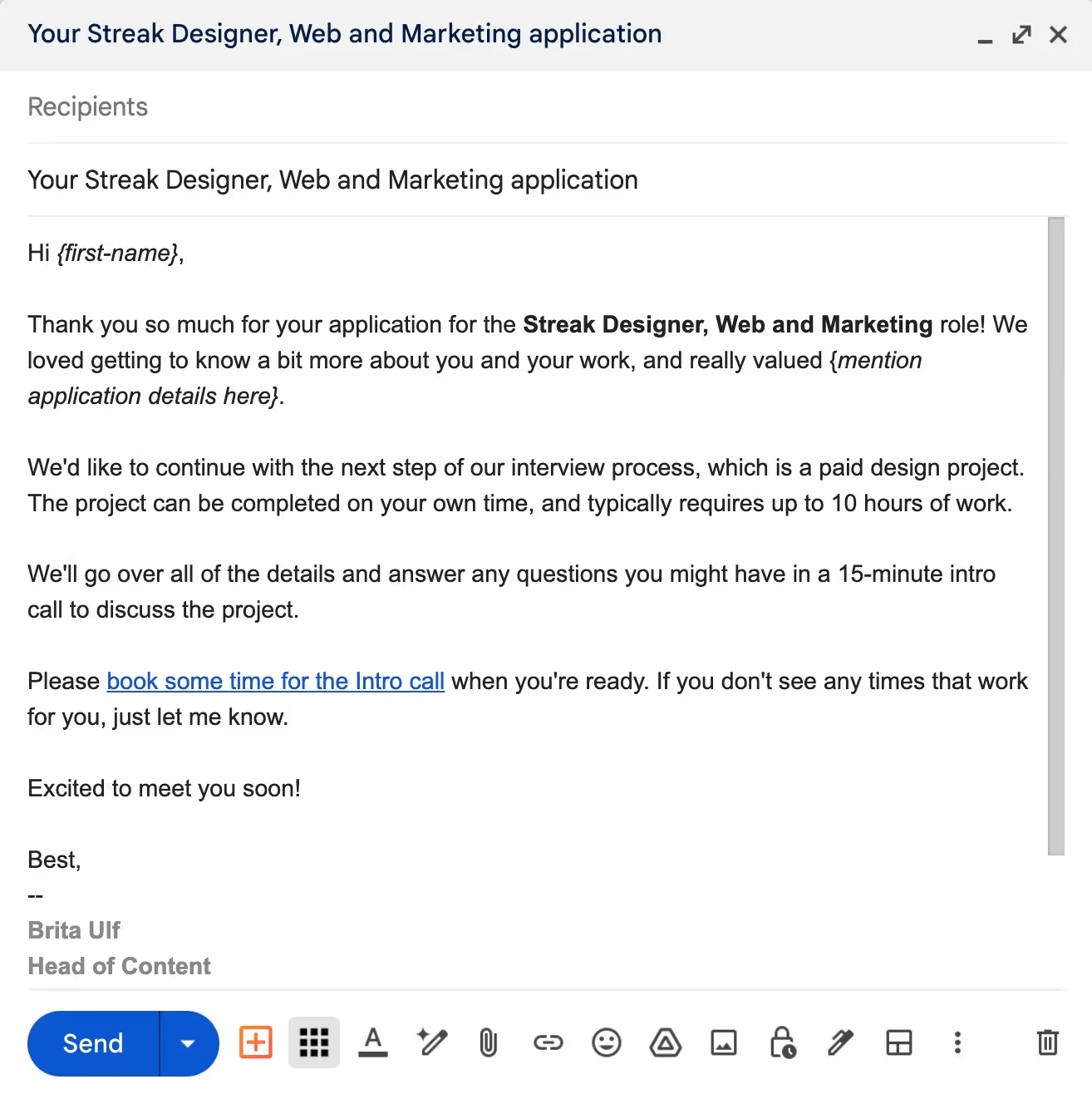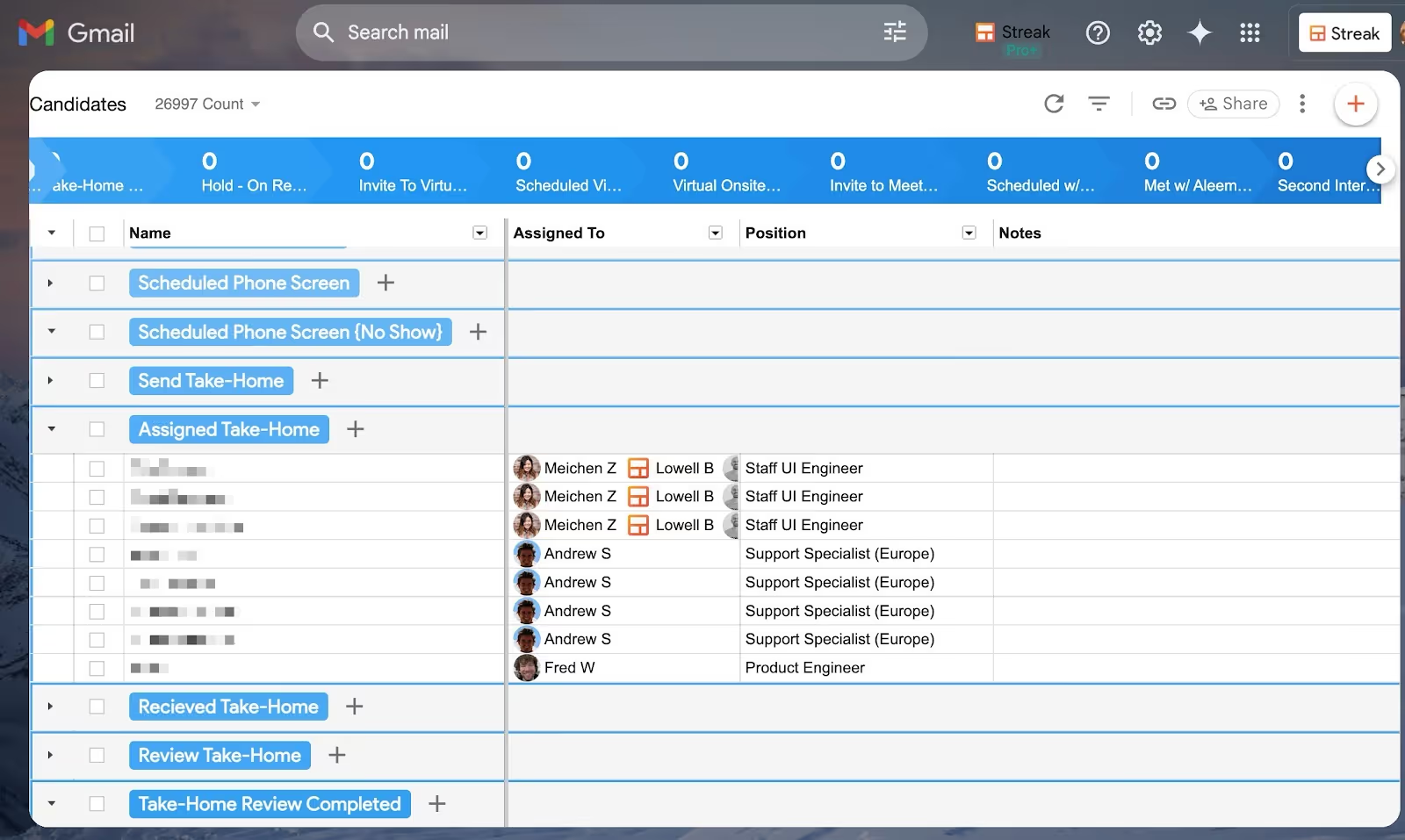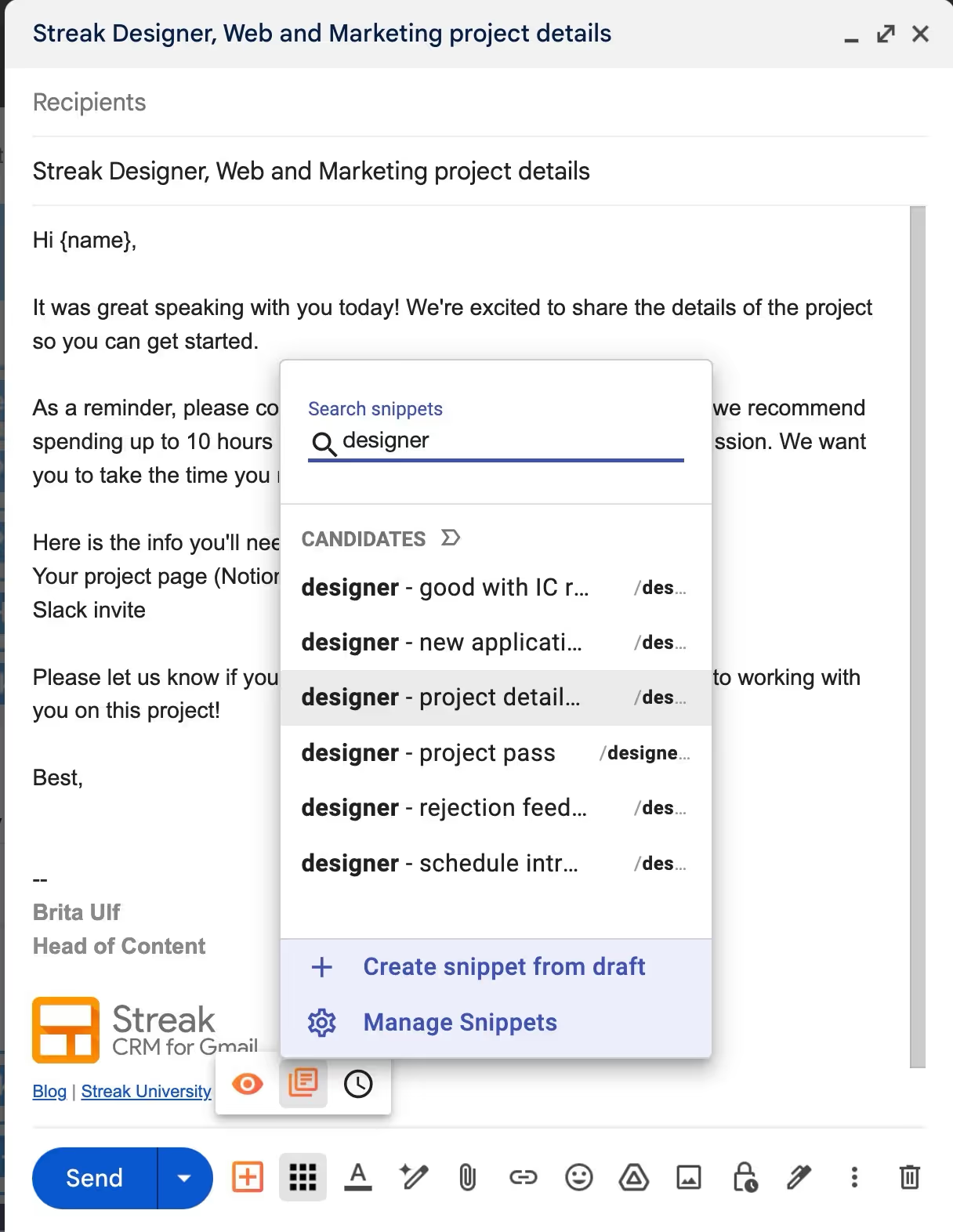Introducing Streak + Slack
Streak is built into your inbox to supercharge your workflow in Gmail, but we know that teams also need information at their fingertips when they communicate internally using tools like Slack.
Earlier this year our CEO, Aleem Mawani, tweeted about a company goal to reach $50M ARR with <50 employees.

It's an aggressive goal that requires an extremely high bar for each new team member we bring on.
Since our current team is made up of around 35 fully remote employees - none of which are recruiters or hiring coordinators - we've had to develop a very deliberate philosophy and process around how we recruit, interview, and hire exceptional individuals.
One of the key components of building our team has been developing an effective interview process. At Streak, we redesigned the traditional job interview to attract and identify candidates who will excel at our company and contribute at a high level.
It looks a little different than your typical job interview, and that's why it works.
A typical interview process usually involves the following steps:
This probably looks familiar, and at some point or another it's probably worked for you as an employer or job seeker. However, this system has some inefficiencies.
Between the initial phone interview and multiple rounds follow-up interviews, the typical hiring process consumes a lot of your team's calendar and requires them to repeatedly align schedules with job candidates.
This is an even bigger challenge if you don't have a recruiting coordinator to help with scheduling.
The typical interview process requires your team to invest a lot of resources early on by spending time on phone interviews, prepping interview questions, and adjusting their schedules before they have enough input to decide if a candidate is truly qualified.
Hiring is one of the most important things we do, and we're eager to invest time, effort, and resources in finding great additions to our team. But we believe we should be dedicating more resources to qualified candidates that have made it further down our hiring funnel.
If your company is hiring for remote roles, this challenge becomes even more complex. Remote roles typically have larger initial applicant pools than in-person jobs, which is absolutely a benefit, but you'll need a more efficient way to evaluate the large quantity of applications you're receiving.
Most job interviews rely on an interrogation-like interview process and common interview questions to move a candidate on to the next stage.
Highly structured interviews that rely on questions and answers between interviewer and interviewee don’t allow candidates to be creative about showcasing their skills and accomplishments.
These types of interviews can also create an unconscious bias against candidates who may be talented but don't excel in purely conversational settings.
All of the scheduling can add days, weeks, and in some cases even months to the end-to-end interview process. This can make for a poor candidate experience and result in losing candidates to companies that move faster.
One of our core hiring principals is that "new hires need to be so obviously good." This helps us achieve our company goals and we know from experience that talented team members are more fun to work with.
On the flip side, bad hires are really expensive for any company. In addition to costing money throughout the hiring and onboarding process, they can drag down an otherwise successful team.
That means we need to get to a "hell yes" for each offer we make - and the traditional interview process wasn't giving us the information we needed to get there.
From years of experience hiring great team members, we developed our own unique virtual interview process. Although we're a fully-remote company, this interview process can also be used to hire for in-person roles.
Remember when I said you should be investing more resources further down in the hiring funnel? Well, we actually invest a lot in the very first step: our job descriptions.
Writing a really solid job description is one of the most important steps in our hiring process. It’s the first impression a candidate gets of us, helps us filter out candidates who aren’t a good fit, and serves as an FAQ. If we’ve done our job right, candidates learn almost everything they need to know without a phone screen.
We invest heavily in crafting these descriptions at the beginning of every hiring process, and it pays dividends.

Here's what makes a Streak job description so effective at the top of our hiring funnel:
The Loom video sets us apart by bringing a personal touch that showcases our culture, team, and role in a way that we just can’t do in writing. It’s our chance to sell candidates on the opportunity, create excitement, and let them envision what it’s like to work at Streak. The video helps them feel like they have a connection with our team and gets them excited about the role before they even speak with anybody.
Recording a video certainly takes time to get right, but it saves us time later by answering common questions about job requirements and helping applicants decide early on if the role is a great fit.
We also ask every candidate to submit their own video explaining why they think Streak is a great fit. This step immediately filters out candidates who aren’t fully committed—recording a video takes effort, and only those genuinely excited about the role will take that step. It also gives us an early sense of their competency and communication right away and allows candidates to present their best selves without the pressure of a live interview.
We review and respond to every single application that's submitted until we fill the role.
Watching the candidate's Loom video, along with reviewing their past work, resume, LinkedIn profile, and other submitted materials, often eliminates the need for phone screens that cover basic questions and small talk.
Collecting enough information in the initial application gives us a better understanding of whether a candidate is a good fit so we can make faster hiring decisions.
Once we find a candidate we're excited about, we reach out to schedule a 15-minute call to meet the candidate face-to-face and introduce the next step of our interview process.

Of course, this is also a great time to catch up on a personal level, answer questions about the role, and discuss the upcoming interview process.
Next, we have the candidate work on a project or complete sample work that could feasibly be something they'd do in the role.
For example, we might have a Web Design candidate map out our website information architecture or work on design for a specific web page. Someone applying for a Customer Success role might be asked to record a video of themselves giving instruction on how to use a Streak feature.
For senior positions and applications that require take-home projects, like engineer and design roles, we cap the project time at 10 hours and pay candidates for their work.
During the project, we encourage candidates to ask questions and collaborate with us via email or Slack.
Now the candidate has invested time in the process through their project or sample work and we want to spend some more time chatting with them. At this point, we're pretty interested in the candidate.
Typically, we'll use this time to go over their project work and share any feedback. This sets the tone early - it's just as important for us to get a feel for how they receive and work with feedback as it is for them to understand how we give feedback.
If there are any points of concern that could be addressed with references, we'll reach out for a reference check.
One of the most important things we’re trying to determine here - and will ask outright - is “would you hire this person again?” We’ll also conduct reference checks if we want another viewpoint on their career history or have concerns about a candidate’s competency in a certain area.
However, our interview process is designed so that we can answer a lot of these questions during collaborative project work.
We all know what this step is! At this point, we're all really excited about a candidate and our team prepares a great offer. We aim to get an offer out quickly and keep the momentum up throughout the entire process.
When Streak went fully remote in 2020, we had to redesign our interview process to accommodate virtual interviews. What we ended up with, however, was a much better way to assess core competencies, evaluate culture fit, and find the best candidate for each role.
The three main ways our interview process achieves this are by:
Adding friction to the application helps us filter candidates early in our interview process. The main way we do this is by requiring candidates to record their own video and submit it with their application.
Recording a good video takes time, which means a candidate has to be really interested in our company and role if they're putting the effort in. If we've done our job right, candidates are sold on the role and willing to put the effort in because of the thorough job description and Loom video from the hiring manager.
Applications without videos are considered incomplete and we'll pass on them. On the flip side, some applicants go above and beyond by clearly putting a lot of thought and effort into their videos - this is always really exciting for us to see.
Interview projects give us a much clearer picture of job performance than polished resumes or situational interview questions. Every step of our interview process is designed to help us evaluate the candidate and to help the candidate evaluate if they would enjoy working at Streak.
Strong asynchronous communication is an important requirement of our fully-remote company. During the project, we set each candidate up with the same tools and communication methods that we use internally.

We create a Notion page for each candidate with all of their project details and invite them to a Slack channel where they can ask questions or get feedback on their work. We ask them to record Loom videos talking through their project submissions.
This gives us a good chance to see if the candidate asks thoughtful questions, can explain their ideas clearly, and remains organized throughout a project.
Although we're evaluating candidates, they're also evaluating us. Our interview process needs to be a positive experience for every candidate - even the ones we pass on.
Another of our hiring principals is to never ghost anyone and provide a fair and timely interview process. Someone who isn't a perfect fit for a current role could be a great candidate in the future or refer others if they have a positive experience with our team.

We commit to an interview process that takes less than two weeks from application to offer. The key is to make sure everyone feels valued and respected, even if they don't ultimately join our team.
We keep our interview process moving quickly by establishing a clear timeline, or service level agreement (SLA), and setting expectations for when a candidate will hear back from us at every step of the process.
Of course, the hard part is sticking to it.
It's helped us to have clear internal roles throughout the interview process. For example, designate somebody to manage your postings on job listing sites and funnel those applicants to your internal candidates pipeline. The hiring manager is responsible for reviewing those applications and responding in accordance to our SLAs. Our CEO sometimes conducts the final interview to make final decisions, and sends offers.
The tools we use allow us to collaborate throughout the interview process keep track of thousands of candidates without anybody slipping through the cracks, and respond to candidates faster.
We use our own product, Streak, to track candidates in Gmail and maintain our commitment to our interview process SLAs. We integrate our application form with our Streak pipeline to automatically add new applications and record their application details.

Pipelines allow us to create a contact for each candidate and include resume files, their video links, social links like LinkedIn profiles, portfolios, and more. We can fill in details we learn during the interview process as well as record interview notes and impressions. All of this is shared with our hiring team members for transparency and so each role in the interview process is looped in at any given time.
In addition to tracking candidates in a pipeline, we use several Streak tools to automate the process and help us respond to candidates faster.

A Streak integration with Typeform and Slack adds new applications to our candidates pipeline as soon as they fill out an application on our website.

It's also set up to ping Slack and notify the hiring manager when new applications are received so we can review them in a timely manner.
We commit to reviewing every single application and giving each candidate a response. To save time while still delivering a personalized experience, we use Streak's mail merge to send responses in bulk.

Mail merge allows us to send individual emails from our own Gmail inboxes and add variables to customize each message.
We mostly use mail merge to pass on applications that aren’t a good fit, since we'll respond to several people at once during that phase of the interview process. Mail merge helps us stick to our commitment of responding to every applicant, while still including some personalization.
For candidates that we want to move forward with, we’ll spend more time crafting emails and communication.
While mail merge is great for sending emails in bulk, Snippets help us send information to individual candidates that move forward in the interview process.

Not only do Snippets save us time, but they create a more fair interview process by communicating with each applicant in a consistent voice and tone and making sure we provide the same information to each person.
We use snippets to:
Since snippets are shared with your team in Streak, team members can cover for each other when needed by responding to candidates with the same messaging that the hiring manager typically uses.
Comments, call logs, and meeting notes help us keep track of conversations and share thoughts and updates with our team internally.
I use comments to record my thoughts about initial applications and project work. When we have a virtual interview or phone call with a candidate, we can record those in call logs. Since we end up evaluating a large number of applications, it's helpful to return to these notes throughout the interview process to remember something a candidate said or my impression on a project.

Importantly, box comments allow us to tag each other in notes and respond directly. Although our hiring managers own most of the interview process, Aleem needs to be able to review details about a candidate or see where they are in our candidates pipeline. This helps us collaborate without turning to Slack or a Google Meet.
There's no one-size-fits-all hiring process. We realized it was important to have a more hands-on interview process to evaluate candidates based on their work and communication. We also needed to account for having candidates, as well as our own team, across multiple countries. Streak allows us to track every step of our process and keep track of application material, notes, and files for each candidate. It also helps us seamlessly collaborate and share thoughts with the rest of the hiring team so we can bring on the best candidates to join our team.
Try Streak free for 14 days to begin tracking your own interview process in Gmail.
Nov 29
